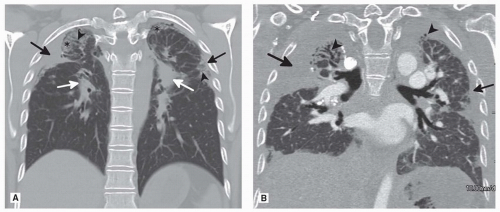Rare Idiopathic Interstitial Pneumonias
Allen P. Burke, M.D.
Marie-Christine Aubry, M.D.
Seth Kligerman, M.D.
Idiopathic Pleuroparenchymal Fibroelastosis
Background
Idiopathic pleuroparenchymal fibroelastosis (PPFE) was initially described in 2004 as a form of idiopathic interstitial pneumonia characterized by predominantly upper lobe subpleural scarring with elastosis.1 Recently, it was recognized as a rare form of idiopathic interstitial pneumonia by the American Thoracic Society/European Society of Respiratory Diseases.2,3 It has also been described as “idiopathic pulmonary upper lobe fibrosis.”4 A related, if not identical, disease was previously described as idiopathic progressive pulmonary fibrosis5 or “Amitani disease” in the Japanese literature. Although initially described in native lungs in patients with normal immune function, PPFE has also been reported in bone marrow transplant recipients6,7 and in lung allografts as a manifestation of restrictive allograft syndrome.8,9
Clinical Findings
PPFE has no gender predilection. It has been described in several patients with prior chemotherapy, including cyclophosphamide,1,10 and has been reported in twins.1 There is no clear association with smoking.4,11 Symptoms include dyspnea, shortness of breath, and nonproductive cough.11 A history of recurrent infections is common. Pneumothorax and pneumomediastinum occur spontaneously or as a complication of treatment and appear more common in PPFE in the setting of bone marrow transplantation.4,7,11 Some patients have incidental pleural thickening noted on chest radiograph years prior to disease manifestation.10 Pulmonary function tests show restrictive ventilatory impairment and decrease diffusion capacity.
Stay updated, free articles. Join our Telegram channel

Full access? Get Clinical Tree



